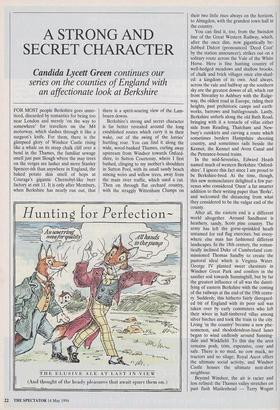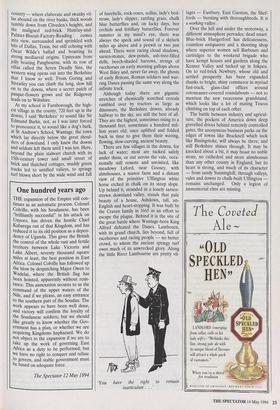A STRONG AND SECRET CHARACTER
Candida Lycett Green continues our
series on the counties of England with an affectionate look at Berkshire
FOR MOST people Berkshire goes unno- ticed, discarded by romantics for being too near London and merely 'on the way to somewhere' for travellers on the M4 motorway, which slashes through it like a surgeon's knife. For them, there is the glimpsed glory of Windsor Castle rising like a whale on its steep chalk cliff over a bend in the Thames, the familiar sewage smell just past Slough where the may trees on the verges are lusher and more Stanley Spencer-ish than anywhere in England, the baked potato skin smell of hops at Courage's gigantic Chernobyl-like beer factory at exit 11. It is only after Membury, when Berkshire has nearly run out, that there is a spirit-soaring view of the Lam- bourn downs.
Berkshire's strong and secret character is far better revealed around the long established routes which carry it in their wake, out of the swing of the lorries' hurtling roar. You can find it along the wide, wood-banked Thames, curling away upstream from Windsor towards Oxford- shire, to Sutton Courtenay, where I first bathed, clinging to my mother's shoulders in Sutton Pool, with its small sandy beach among weirs and willow trees, away from the main river traffic, which used a cut. Then on through flat orchard country, with the straggly Wittenham Clumps on their two little rises always on the horizon, to Abingdon, with the grandest town hall in the country.
You can find it, too, from the Swindon line of the Great Western Railway, which, after the once dim, now gigantically be- Jubbed Didcot (pronounced 'Deed Coat' by the station announcer), strikes out on a solitary route across the Vale of the White Horse. Here is fine hunting country of well-hedged meadows and shallow brooks, of chalk and brick villages once elm-shad- ed: a kingdom of its own. And always, across the vale and halfway up the southern sky are the greatest downs of all, which run from Streatley to Ashbury with the Ridge- way, the oldest road in Europe, riding their heights, past prehistoric camps and earth- works, barrows and battlegrounds. Lastly, Berkshire unfurls along the old Bath Road, bringing with it a tentacle of villas either side from Reading, Thatcham and New- bury's outskirts and carving a route which sometimes borders Hampshire shooting country, and sometimes sails beside the Kennet, the Kennet and Avon Canal and the Penzance-bound trains.
In the mid-Seventies, Edward Heath named much of western Berkshire 'Oxford- shire'. I ignore this fact since I am proud to be Berkshire-bred. At the time, though, this new nomenclature delighted a few par- venus who considered 'Oxon' a far smarter addition to their writing paper than ‘Berks', and welcomed the distancing from what they considered to be the vulgar end of the county.
After all, the eastern end is a different world altogether. Around Sandhurst is heathery, sandy, Scots pine country. The army has left the gorse-sprinkled heath untamed for red flag exercises, but every- where else man has fashioned different landscapes. In the 18th century, the roman- tically inclined Duke of Cumberland com- missioned Thomas Sandby to create the pastoral ideal which is Virginia Water. George IV planted sweet chestnuts in Windsor Great Park and conifers in the sandier soil towards Sunninghill, but by far the greatest influence of all was the dainti- fying of eastern Berkshire with the coming of the railways at the end of the 19th centu- ry. Suddenly, this hitherto fairly disregard- ed bit of England with its poor soil was taken over by early commuters who left their wives in half-timbered villas among silver birches and took the train to the city. Living in the country' became a new phe- nomenon, and rhododendron-lined lanes began to wind endlessly around Sunning- dale and Winkfield. To this day the area remains posh, trim, expensive, cosy and safe. There is no mud, no cow muck, no tractors and no silage; Royal Ascot offers the ultimate social activity, and Windsor Castle houses the ultimate next-door neighbour.
Beyond Windsor, the air is racier and less refined: the Thames valley stretches on past flash Maidenhead — Terry Wogan country — where elaborate and swanky vil- las abound on the river banks, thick woods tumble down from Cliveden's heights, and the maligned red-brick Huntley-and- Palmer-Biscuit-Factory-Reading comes into view, surrounded and sprinkled with bits of Dallas, Texas, but still echoing with Oscar Wilde's ballad and boasting its strong mediaeval origins. Upstream from jolly boating Pangbourne, with its row of villas called the Seven Deadly Sins, the western wing opens out into the Berkshire that I know so well. From Goring and Streatley you can climb the long, slow hill on to the downs, where a secret patch of pasque-flowers grows and the Ridgeway leads on to Wiltshire.
At my school in Farnborough, the high- est village in the county, 720 feet up in the downs, I said 'Berkshire' to sound like Sir Edmund Burke, not, as I was later forced to pronounce it, to sound like a dog's bark, at St Andrew's School, Wantage, the town which lay directly below the great shoul- ders of downland. I only knew the downs and seldom left them until I was ten. Here, beyond the plain stalwart church with its 15th-century tower and small street of brick and thatched cottages, muddy green tracks led to untilled valleys, to springy turf blown short by the wide wind and full
of harebells, rock-roses, scillas, lady's bed- straw, lady's slipper, rattling grass, chalk blue butterflies and, on lucky days, bee orchids and fritillary butterflies. Forever summer in my mind's eye, there was always the speck and sound of a skylark miles up above and a peewit or two just ahead. There were racing cloud shadows, sarsen-stones, dew-ponds, ash-tree-filled dells, beech-shaded barrows, strings of racehorses on early morning gallops above West Ilsley and, never far away, the ghosts of early Britons, Roman soldiers and war- ring Danes passing the same way along the infinite track.
Although today there are gigantic stretches of chemically scorched cereals rumbled over by tractors as large as dinosaurs, the Berkshire downs, already halfway to the sky, are still the best of all. They are the highest, sometimes rising to a thousand feet, sometimes a hundred mil- lion years old; once uplifted and folded back in time to give them their waving, flowing, slow-curving, ancient beauty. There are few villages in the downs, for lack of water; most are tucked safely under them, or out across the vale, occa- sionally still remote and unvisited, like meadowy Lyford, near Goosey, with almshouses, a manor farm and a distant view of the primitive Uffington white horse etched in chalk on its steep slope. Up behind it, stranded in a lonely sarsen- strewn downland valley, stands that pale beauty of a house, Ashdown, tall, un- English and heart-stopping. It was built by the Craven family in 1665 in an effort to escape the plague. Behind it is the site of the great battle where Wantage-born King Alfred defeated the Danes. Lambourn, with its grand church, lies beyond, full of racehorses and racing people — no better crowd, to whom the ancient springy turf owes much of its unwrecked glory. Along the little River Lambourne are pretty vil- 'You have the right to remain inarticulate . . lages — Eastbury, East Garston, the Shef- fords — bursting with thoroughbreds. It is a working valley.
Over the hill and under the motorway, a different atmosphere pervades: dead smart. Blue-brick Hungerford has delicatessens, countless antiquaires and a shooting shop where superior women sell Barbours and cartridges to the weekend brigade who have kempt houses and gardens along the Kennet Valley and tucked up in Inkpen. On to red-brick Newbury, whose old and settled prosperity has been expanded thanks to bright, shiny commerce in myriad fast-track, glass-clad offices around cotoneaster-covered roundabouts — not to mention the new racecourse grandstand, which looks like a lot of mating Tescos climbing on top of each.other.
The battle between industry and agricul- ture, the pockets of America down deep gravelled drives behind remotely controlled gates, the anonymous business parks on the edges of towns like Bracknell which look like Basingstoke, will always be there; and still Berkshire shines through. It may be knocked about a bit, it may boast no noble stone, no cathedral and more almshouses than any other county in England, but its heart is strong, and much of its character — from sandy Sunninghill, through valleys, vales and downs to chalk-built Uffington remains unchanged. Only a legion of immemorial elms are missing.



























































 Previous page
Previous page